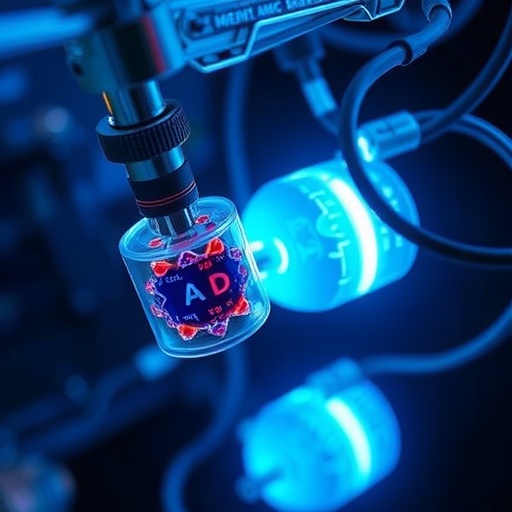In a groundbreaking advancement in nuclear fusion technology, researchers have demonstrated a substantial enhancement in deuterium fusion rates through innovative electrochemical loading of palladium metal targets. This pioneering approach integrates a plasma ion implantation system with precision electrochemical control, enabling conditions favorable for fusion within a compact and controllable reactor environment. The experiment, conducted within what the researchers call the Thunderbird Reactor, offers new avenues for scalable fusion energy production, potentially revolutionizing clean energy generation.
The entire reactor assembly operates within an ultra-high vacuum environment, maintained by a sophisticated vacuum chamber system that achieves pressures as low as 5 × 10⁻⁸ torr. The vacuum chamber, constructed with standard ConFlat flange technology, connects the plasma thruster directly to an electrochemical cell where the palladium target resides. This vacuum integrity ensures minimal contamination and precise control of ion energies during plasma immersion ion implantation (PIII), critical for sustaining high-quality fusion conditions on the metal cathode surface.
.adsslot_1jht6SwK9X{width:728px !important;height:90px !important;}
@media(max-width:1199px){ .adsslot_1jht6SwK9X{width:468px !important;height:60px !important;}
}
@media(max-width:767px){ .adsslot_1jht6SwK9X{width:320px !important;height:50px !important;}
}
ADVERTISEMENT
Experimental protocols involve initially stabilizing beam loading with deuterium ions implanted into the palladium target at a plasma current of 0.5 mA. Neutron production rates serve as the primary indicator of fusion activity, with parity achieved after approximately 30 minutes of stabilized operation. Upon reaching this steady state, activation of the electrochemical cell induces significant increases in deuterium concentration within the palladium lattice, as confirmed by sophisticated in situ X-ray diffraction (XRD) studies demonstrating the α-Pd to β-Pd phase transition indicative of high D/Pd ratios.
Palladium target preparation plays a pivotal role in ensuring reproducible and reliable fusion conditions. The targets are cold-rolled from high purity palladium bars to a precise 300 μm thickness, cut into 2.4 cm diameter discs, and subjected to high vacuum annealing at 400 °C to expunge residual hydrogen isotopes. This preparation guarantees an initial undoped state for each experiment. Subsequent fusion reactions and electrochemical loading processes produce well-characterized β-phase palladium deuteride, which supports higher deuterium retention essential for the observed fusion enhancements.
The in situ XRD measurements represent a highlight of the research, providing a window into real-time changes within the palladium lattice under simultaneous electrochemical loading and plasma implantation. The measurements clearly capture the lattice expansion and phase evolution reflecting deuterium incorporation. Remarkably, the β-Pd phase maintains stability for extended periods both under ambient conditions and vacuum, bolstering the argument that electrochemical loading induces sustained modifications conducive to nuclear reaction facilitation.
Detailed vacuum system monitoring and control complement the physical and chemical controls within the reactor. The arrangement of turbo pumps, dry scroll pumps, pressure gauges, and residual gas analyzers ensures that the environment remains pristine and contaminant-free, a prerequisite for consistent plasma behavior and target integrity. Fine control of these parameters circumvents the challenges historically associated with plasma thruster operation in fusion research, enabling sustained and reproducible conditions for ion implantation.
The integration of a high-voltage power supply with PID feedback control exemplifies the advanced automation underpinning the Thunderbird Reactor’s operation. Current feedback from the high-voltage supply allows dynamic adjustments to plasma current, maintaining the delicate balance required for ion sheath formation without damaging the palladium target. This closed-loop control is essential for extended experiments, supporting neutron detection and fusion rate stabilization over periods extending to several hours.
A particularly novel aspect of the research is the demonstration of electrochemical cycling effects on neutron output. By toggling the galvanostat on and off during continuous beam loading, the researchers showcase how fusion reaction rates correspondingly fluctuate, evidencing the direct role of electrochemical deuterium loading on enhancing fusion probabilities. This insight opens the door for dynamic modulation of fusion activity, contributing to practical considerations for reactor control and efficiency optimization.
The theoretical underpinnings of palladium deloading, based on Sieverts’ law, guide the rigorous annealing protocols employed. By modeling hydrogen partial pressures and temperatures, the researchers ensure the removal of hydrogen isotopes from the palladium lattice prior to experiments, a crucial step validated by precise XRD characterization. This approach guarantees that measured fusion enhancements result from experimental manipulations rather than residual contamination, adding credibility to the observed phenomena.
Ultimately, this research demonstrates the power of coupling electrochemistry with plasma ion implantation to achieve significant enhancements in nuclear fusion rates within a compact metal target. The meticulous engineering of the plasma thruster, vacuum environment, and electrochemical cell system, combined with real-time lattice monitoring, creates a unique platform for investigating low-energy nuclear fusion mechanisms. The intrinsic scalability and controllability of the Thunderbird Reactor suggest promising avenues for future clean energy devices leveraging metal-hydride catalyzed fusion reactions.
This pioneering investigation not only pushes the boundaries of nuclear fusion science but also sets the stage for further exploration of electrochemically enhanced fusion materials. The detailed insights into material phases, vacuum engineering, plasma control, and electrochemical coupling constitute a remarkable advancement in the pursuit of sustainable and practical fusion energy sources. As the world seeks alternatives to fossil fuels, such breakthroughs inspire optimism for fusion’s eventual role as a mainstream energy solution.
Subject of Research: Electrochemical enhancement of deuterium fusion rates in palladium metal targets using plasma thruster ion implantation and in situ X-ray diffraction characterization.
Article Title: Electrochemical loading enhances deuterium fusion rates in a metal target.
Article References:
Chen, K.Y., Maiwald, J., Schauer, P.A. et al. Electrochemical loading enhances deuterium fusion rates in a metal target. Nature 644, 640–645 (2025). https://doi.org/10.1038/s41586-025-09042-7
Image Credits: AI Generated
DOI: https://doi.org/10.1038/s41586-025-09042-7
Tags: advancements in fusion energy generationcompact fusion reactor technologydeuterium fusion enhancement techniqueselectrochemical loading in nuclear fusioninnovative plasma ion implantation systemsion implantation in palladium targetsPID control in plasma ignitionprecision electrochemical control methodsscalable clean energy productionstainless steel plasma thruster designThunderbird Reactor advancementsultra-high vacuum environments in fusion





